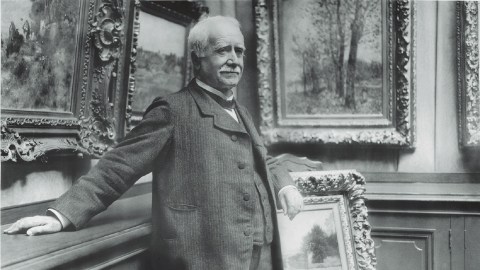The Gambler: How Paul Durand-Ruel Bet Big on Impressionism (and Won)

What would you do? Imagine you’re a politically conservative, devoutly religious art dealer fleeing your war-torn country when you suddenly see art radically unlike anything you’ve seen before. Do you stay the course or gamble on this next “big thing”? Now add the sudden death of your pregnant young wife, which leaves you with five children under the age of nine whose futures now depend entirely on your choices. Do you roll the dice with your life and theirs? If you’re Paul Durand-Ruel and that artist is Claude Monet, the original Impressionist, you don’t just make that bet; you go “all in” — staking your family’s fortunes to those of a family of revolutionary artists. The exhibition Discovering the Impressionists: Paul Durand-Ruel and the New Painting, currently at the Philadelphia Museum of Art, goes “all in” with Durand-Ruel’s gamble and pays off big with a stirring tale of personal courage and art history in the making.
Durand-Ruel’s role in the birth and eventual success of Impressionism as a key foundation of modern art has long been acknowledged. “The man was more than the dealer of the Impressionists,” John Rewald wrote in 1943. “He was their defender and friend, among the first to understand their revolutionary art, and for many years the only one with courage enough to invest up to his last cent in their paintings, a gesture which often brought him near bankruptcy.” Before that critical, public acclaim, the painters themselves praised Durand-Ruel as a savior — the man who consistently bought their paintings when few others did, the man who promoted their art better than they could themselves, and the man who struggled financially to ensure that they could literally stave off starvation and keep working.
Beyond Impressionism, Durand-Ruel helped shape the modern art market itself. “Credited with a double ‘invention,’ that of Impressionism and the profession of the modern art dealer,” the catalog introduction asserts, “Paul Durand-Ruel occupies a central position in the cultural history of art and taste, one on which paintings retain their pre-eminent position.” The quotes around “invention” are important, for despite the big banner hyperbole of Durand-Ruel as the man who “made the Impressionists” (a small, but growing market had begun years before Durand-Ruel became involved) and the man who revolutionized art dealing (he copied innovations of other dealers), Durand-Ruel’s true originality and genius reside in his gutsy determination to go bigger and bolder than any dealer of the Impressionists before. Anything less and modern art history and the modern art market wouldn’t resemble what they look like today.
The son of an art dealer, Durand-Ruel joined the family business after considering careers in the military and missionary service. Durand-Ruel brought his militant, true-believer’s zeal to the field of art in first supporting the “School of 1830” — Eugène Delacroix, Jean-Baptiste-Camille Corot, Jean-François Millet, and Theodore Rousseau. As Durand-Ruel’s descendants, Paul-Louis and Flavie Durand-Ruel, explain in the catalog, if Paul had died in 1870, “he would have been considered the most fervent champion of the 1830 school.” It took decades for the public and critics to catch up with the “School of 1830,” but by then, Durand-Ruel was already championing newer artists such as Gustave Courbet, whose radical politics couldn’t have clashed more with the conservative Durand-Ruel’s, but nevertheless the two formed a close relationship over Courbet’s art.
In many ways, Durand-Ruel’s support of Delacroix and his contemporaries set the stage for his later support of the Impressionists. Having bet big once and won, Durand-Ruel felt confident enough to bet on the latest set of revolutionaries. Also, just as the market for the 1830 crew blossomed and stabilized Durand-Ruel’s business, he folded that money back into the business with large-scale purchases of Impressionist art. (Simon Kelly’s wonderful catalog essay argues for the importance of this overshadowed aspect of his story.) Durand-Ruel himself saw a clear link between the two generations, once even owning Henri Fantin-Latour’s Homage to Delacroix, a “class picture” of sorts of 1860s artists (including Édouard Manet) surrounding and paying tribute to a portrait of Delacroix, and exhibiting it as “context” to help others make the connection between the old and new styles.
The exhibition develops as a series of curatorial “case studies” in which Durand-Ruel’s strategies and techniques shine through as he came closer and closer to the idea of the “dealer-critic” of today. One gallery reassembles key works from Durand-Ruel’s controversial 1876 Impressionist exhibition that made few sales, but several critical enemies dubious about Monet and company. Two galleries recreate the solo exhibitions Durand-Ruel staged for Monet, the first being a mid-career retrospective in 1883 and the second being a smaller, more focused exhibition of Monet’s Poplars series from 1892. Another gallery reunites works Durand-Ruel exhibited and sold in his New York City gallery (opened in 1887), to which American collectors flocked and from which Impressionism spread across America more quickly than it had in Europe. The largest exhibition of Impressionism then or since (more than 300 works) — Durand-Ruel’s 1905 Grafton Galleries show in London — lives again in a gallery hosting selections by Manet, Monet, Camille Pissarro, Edgar Degas, Pierre-Auguste Renoir, and others and serves as a triumphant “told you so” as much today as it did back then. A final, more intimate gallery recreates Durand-Ruel’s home as a showplace for his artistic and actual families, with portraits of his children commissioned from Renoir reminding you of everything that was on the line throughout this remarkable story.
For me, seeing art history take shape on the fly this way opened up whole new dimensions of the Impressionists. We’re so used to posthumous retrospectives of these figures that the idea of a mid-career retrospective with input from Monet himself paints an entirely different picture. It’s not just a snapshot of an artist at that moment. It’s a selfie! We see them as they (and Durand-Ruel) wanted to be seen. Looking at (the now privately owned) The Church at Varengeville, Morning Effect (1882) by Monet, with its bold low perspective and even bolder verticals snaking down the cliff face in the morning sun, you realize just how radical Monet once was and, more importantly, wanted to be. Likewise, the room of Poplars seems elementary to modern eyes used to Monet’s series, but to viewers in 1892 it was a revelation and to Monet it was the ideal setting to showcase his intentions. The retrospective sold poorly, but the Poplars show sold out almost before it opened, providing Monet with the funds to purchase his home at Giverny, where he painted not only the Poplars, but also so many other signature works. So, no Durand-Ruel, no solo exhibitions, no Poplars sales, no Giverny, no Water Lillies, no Monet as we’ve come to know and love. The chain of cause and effect is clear.
Another clear chain of cause and effect in the telling of Durand-Ruel’s story is between venue and narrative. This exhibition began in Paris at the Musée de Luxembourg, where they understandably focused on the Parisian part; continued to London and the National Gallery, which naturally targeted Durand-Ruel’s British invasion; and concludes in Philadelphia, where the PMA plays up the American angle, specifically local favorite Mary Cassatt’s role as artist, collector, and mentor to fellow American collectors. Cassatt scholar and feminist art theorist Griselda Pollock accused the National Gallery, London, not only of overly downplaying Cassatt’s role, but also (more seriously) of “erasing women from the history of art.” I can see Pollock’s point, but can also see the thinking behind the National Gallery’s curatorial choices to winnow down such a multifaceted story. Fortunately, Philadelphia corrects any previous errors of exclusion by giving Cassatt due credit, including adding additional works from their Cassatt collection to better represent her visually. The Durand-Ruel—Philadelphia connection might have been even bigger and better if The Barnes Foundation, which is literally down the street from the PMA, could have been brought into the picture. Dr. Albert Barnes purchased so frequently from Durand-Ruel that he joked to the dealer that “my collection is practically an annex of your business.” Alas, for undisclosed reasons, the Barnes Foundation couldn’t be a valuable “annex” to this exhibition.
A French art critic in 1911 called Durand-Ruel “simplicity itself” in demeanor, but also recognized “every mark of uncommon obstinacy, of an unyielding yet nonviolent will that is imposed with a smile.” Like a good poker player, Durand-Ruel knew when to hold ‘em, and knew when to fold ‘em — all with a smile beaming from an unshakable faith in his own judgment and the talent of his artist friends. Discovering the Impressionists: Paul Durand-Ruel and the New Painting opens with Hugues Merle’s portrait of the dealer at 35 looking directly at the viewer with the brash confidence of youth. The show concludes with a portrait by his friend Renoir of the dealer at 79, eyes downcast and musing on the trials and triumphs of the past as he eases into the comfort of age and a mission completed. Between those two portrait bookends sits a story of courage and perseverance that led to a chapter in art history that will never be erased. Bet on it.
[Image: Photograph of Paul Durand-Ruel:Paul Durand-Ruel in His Gallery, c. 1910, by Dornac (Archives Durand-Ruel) © Durand-Ruel & Cie.]
[Many thanks to the Philadelphia Museum of Art for providing me with the image above from, a review copy of the catalog to, press materials related to, and a press preview invitation for the exhibition Discovering the Impressionists: Paul Durand-Ruel and the New Painting, which runs through September 13, 2015.]
[PLEASE NOTE: Philadelphia is the only United States venue for this exhibition, but an excellent film of the exhibition, titled The Impressionists and the Man Who Made Them, will be shown in select cinemas nationwide on July 14, 2015 through FathomEvents.com. Theater locations can be found here.]
[Please follow me on Twitter (@BobDPictureThis) and Facebook (Art Blog By Bob) for more art news and views.]





